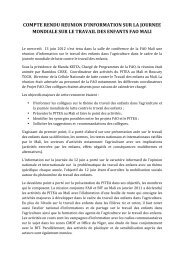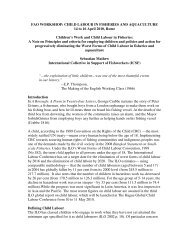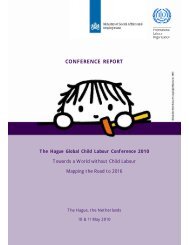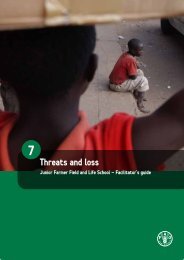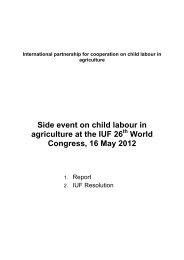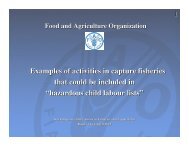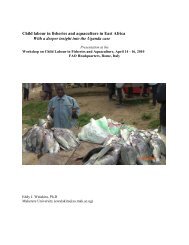Mainstreaming responses to the girl child in agriculture - Food ...
Mainstreaming responses to the girl child in agriculture - Food ...
Mainstreaming responses to the girl child in agriculture - Food ...
You also want an ePaper? Increase the reach of your titles
YUMPU automatically turns print PDFs into web optimized ePapers that Google loves.
1. Introduction<br />
The goal set by governments (and <strong>the</strong> <strong>in</strong>ternational community) is <strong>the</strong> progressive<br />
elim<strong>in</strong>ation of all forms of <strong>child</strong> labour worldwide, with priority given <strong>to</strong> elim<strong>in</strong>ate<br />
without delay what are termed '<strong>the</strong> worst forms of <strong>child</strong> labour' (WFCL). The WFCL, as<br />
def<strong>in</strong>ed <strong>in</strong> <strong>the</strong> International Labour Organization’s (ILO) Convention No. 182 <strong>in</strong>clude<br />
all forms of slavery, traffick<strong>in</strong>g of <strong>child</strong>ren, use of <strong>child</strong> soldiers, commercial sexual<br />
exploitation, <strong>the</strong> use of <strong>child</strong>ren <strong>in</strong> illicit activities, and hazardous <strong>child</strong> labour. The<br />
latter category is particularly relevant <strong>to</strong> <strong>agriculture</strong>.<br />
Accord<strong>in</strong>g <strong>to</strong> <strong>the</strong> ILO (2006a), an estimated 70 per cent of <strong>the</strong> world’s <strong>child</strong><br />
labourers 1 are agricultural workers. The number of <strong>child</strong> labourers <strong>in</strong> <strong>the</strong> agricultural<br />
sec<strong>to</strong>r is considered <strong>to</strong> be nearly ten times higher than <strong>the</strong> number of <strong>child</strong> labourers <strong>in</strong><br />
o<strong>the</strong>r sec<strong>to</strong>rs (such as <strong>in</strong> fac<strong>to</strong>ries, m<strong>in</strong><strong>in</strong>g, etc) (ILO, 2006a). As a result both boys and<br />
<strong>girl</strong>s work <strong>in</strong> a sec<strong>to</strong>r with a poor health and safety record. Yet, <strong>the</strong>re has been less<br />
research <strong>to</strong> understand and develop strategies for combat<strong>in</strong>g <strong>child</strong> labour <strong>in</strong> <strong>agriculture</strong><br />
and rural employment, (especially <strong>the</strong> worst/most hazardous forms of <strong>child</strong> labour)<br />
when compared <strong>to</strong> o<strong>the</strong>r sec<strong>to</strong>rs 2 . The agricultural workforce rema<strong>in</strong>s one of <strong>the</strong> largest<br />
workforce sec<strong>to</strong>rs <strong>in</strong> <strong>the</strong> world and <strong>in</strong>dications are that this workforce is be<strong>in</strong>g<br />
<strong>in</strong>creas<strong>in</strong>gly fem<strong>in</strong>ised with self-employed women farmers, waged <strong>agriculture</strong> women<br />
workers and sadly, <strong>girl</strong> <strong>child</strong> labourers. Yet, evidence of specific research focussed on<br />
<strong>girl</strong> <strong>child</strong> labour <strong>in</strong> <strong>agriculture</strong> is scant, although some reports do exist on this <strong>to</strong>pic.<br />
The reason for focuss<strong>in</strong>g on gender equality issues <strong>in</strong> <strong>child</strong> labour relates <strong>to</strong> <strong>the</strong> issue of<br />
whe<strong>the</strong>r boys and <strong>girl</strong>s are be<strong>in</strong>g given equal rights and opportunities from an early age.<br />
In some countries and cultures, <strong>in</strong>dica<strong>to</strong>rs demonstrate that <strong>the</strong> <strong>girl</strong> <strong>child</strong> is<br />
discrim<strong>in</strong>ated aga<strong>in</strong>st from <strong>the</strong> earliest stages of life, throughout her <strong>child</strong>hood and <strong>in</strong><strong>to</strong><br />
adulthood. Unfortunately, <strong>girl</strong>s’ work <strong>in</strong> <strong>agriculture</strong> (like <strong>the</strong>ir female relatives) can<br />
often be <strong>in</strong>visible, and <strong>the</strong>ir work is typically not given <strong>the</strong> same value as boys. Girls<br />
also face a double burden of domestic work on <strong>to</strong>p of agricultural work. Agricultural<br />
work for <strong>girl</strong>s and boys often results <strong>in</strong> less opportunities for obta<strong>in</strong><strong>in</strong>g an education.<br />
Invest<strong>in</strong>g <strong>in</strong> <strong>the</strong> education of <strong>girl</strong>s is important from a number of equity and efficiency<br />
reasons.<br />
It must be stressed that not all work that boys and <strong>girl</strong>s undertake <strong>in</strong> <strong>agriculture</strong> is<br />
harmful for <strong>the</strong>m. Age-appropriate tasks that are of lower risk and do not <strong>in</strong>terfere with<br />
a <strong>child</strong>’s school<strong>in</strong>g and right <strong>to</strong> leisure time can be normal part of grow<strong>in</strong>g up <strong>in</strong> a rural<br />
environment, and provide valuable work experience as a basis for future employment.<br />
Such age appropriate tasks are not <strong>in</strong> question here. However with much agricultural<br />
work, boys and <strong>girl</strong>s are at greater risk from <strong>the</strong> same hazards than adult workers<br />
encounter. This is because of a comb<strong>in</strong>ation of physical, psychological and social<br />
reasons based on <strong>the</strong> reality that <strong>the</strong> bodies, m<strong>in</strong>ds and personalities of <strong>child</strong>ren are still<br />
grow<strong>in</strong>g and develop<strong>in</strong>g (ILO-IPEC 2009; Doorman, 2008).<br />
An <strong>in</strong>tegrated approach <strong>to</strong> tackl<strong>in</strong>g <strong>child</strong> labour <strong>in</strong> <strong>agriculture</strong> requires a focus<br />
across a number of sec<strong>to</strong>rs (education, poverty reduction, <strong>agriculture</strong>, employment). The<br />
argument that <strong>child</strong> labour concerns should become more ‘<strong>in</strong>tegrated’ <strong>in</strong><strong>to</strong> policy with<br />
more ma<strong>in</strong>stream <strong>responses</strong> has ga<strong>in</strong>ed momentum (<strong>in</strong> order <strong>to</strong> ensure jo<strong>in</strong>ed-up<br />
th<strong>in</strong>k<strong>in</strong>g amongst all responsible agencies and rural communities). In order <strong>to</strong> support<br />
U. Murray, P. Hurst - Draft for discussion - 2





